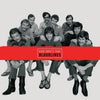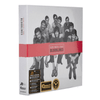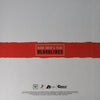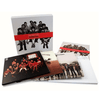







Blood, Sweat & Tears - Bloodlines (8LP, Coffret, 45 tours, 200g)
[click here to see more vinyl featuring Blood, Sweat & Tears]
COMPILATION OF 4 ALBUMS:
- Child Is Father To The Man
- Blood, Sweat & Tears Self-Titled
- Blood, Sweat & Tears 3
- Blood, Sweat & Tears 4
8 LP, box set, Booklet with essay by lead singer David Clayton-Thomas and rare photos
Original analog Master tape : YES
Heavy Press : 200g
Record color : black
Speed : 45 RPM
Size : 12'’
Stereo
Studio
Record Press : Quality Record Pressings
Label : Analogue Productions
Original Label : Columbia
Remastered by Ryan K. Smith at Sterling Sound
Released in 2017
Tracks:
Child Is The Father To The Man
Side A:
- Overture
- I Love You More Than You'll Ever Know
- Morning Glory
Side B:
- My Days Are Numbered
- Without Her
- Just One Smile
Side C:
- I Can't Quit Her
- Meagan's Gypsy Eyes
- Somethin’ Goin’ On
Side D:
- House In The Country
- The Modern Adventures Of Plato, Diogenes And Freud
- So Much Love / Underture
Blood, Sweat & Tears
Side E:
- Variations On A Theme By Erik Satie (1st And 2nd Movements)
- Smiling Phases
- Sometimes In Winter
Side F:
- More And More
- And When I Die
- God Bless The Child
Side G:
- Spinning Wheel
- You’ve Made Me So Very Happy
Side H:
- Blues - Part II
- Variation On A Theme By Erik Satie (1st Movement)
Blood, Sweat & Tears 3
Side I:
- Hi-De-Ho
- The Battle
Side J:
- Lucretia Mac Evil
- Lucretia’s Reprise
- Fire And Rain
- Lonesome Suzie
Side K:
- Symphony For The Devil
- He’s A Runner
Side L:
- Somethin’ Comin’ On
- 40,000 Headmen
Blood, Sweat & Tears 4
Side M:
- Go Down Gamblin’
- Cowboys And Indians
- John The Baptist (Holy John)
Side N:
- Redemption
- Lisa, Listen To Me
- A Look To My Heart (Instrumental)
Side O:
- High On A Mountain
- Valentine’s Day
- Take Me In Your Arms (Rock Me A Little While)
Side P :
- For My Lady
- Mama Gets High
- A Look To My Heart
Reviews:
“BS&T fans fall into 4 camps: the 1st which prefers the Al Kooper led original group and the album Child is Father to the Man, the 2nd that prefers only the second eponymously titled album, which was the group's most popular, the 3rd camp that loves the first two albums and the 4th camp that loves all of the group's albums. This box is definitely for them.
Horn-based jazz-rock bands were non-existent when the first BS&T album was released in 1968—not that horn sections had not previously been used on rock records. That first album was an unusual and provocative blend of fuzz toned guitar, horns, psychedelia (including the then novel sound of "flanging") and sumptuous strings all in service of a great set of originals by the group's musical director Al Kooper, with one memorably Steve Katz contribution ("Meagan's Gypsy Eyes") and cover tunes by Tim Buckley, Harry Nillsonn (sic), Randy Newman and Goffin-King.There was some humor (some of which doesn't wear well with time), but mostly there was New York City/Queens soul provided by Kooper, who, while he took the music seriously, never took himself too seriously.
Add Producer/arranger John Simon's eclectic touch and Fred Catero's skilled engineering and you have an album (recorded in two weeks) that blew the pants off of unsuspecting buyers, some of whom knew Kooper from his contributions to Bob Dylan's Highway 61 Revisited album (echoed in the "Morning Glory" arrangement) and Steve Katz from his Blues Project days with Kooper. The horns were fabulous, with Randy Brecker, (!), Dick Halligan and Jerry Weiss, plus Fred Lipsius on alto sax (and piano) and not a "section" per se, but an actual part of the group, which is part of what made the record so special. Also on board and making key contributions were ex-Buffalo Springfield and Mothers of Invention bassist Jim Fielder and powerhouse drummer Bobby Colomby.
But the record wasn't a big seller, both because the concept was new and didn't appeal to the rock masses or the jazz community and because it felt like such a New York-centric product. The Kooper-inspired cover (the transposed head bit which he repeated a few more times) probably creeped a lot of people out as well. Still a great album though.
Al Kooper began working on the second album but Katz and Colomby thought Kooper a weak singer and wanted him hand the lead to someone else and relinquish musical control too, so he left as did Randy Brecker who joined Horace Silver (who could blame him?), replaced by the late Lou Soloff.
Canadian belter/white soul singer David Clayton-Thomas (who also annotates the booklet) joined as lead singer. Produced by James William Guercio around the same time he was producing Chicago's debut album and engineered by Roy Halee, Blood, Sweat & Tears quickly became a huge world-wide hit, spawning in its wake a profusion of top ten singles including Brenda Holloway's "You've Made Me So Very Happy", Clayton-Thomas's "Spinning Wheel/More and More" and Laura Nyro's "And When I Die".
The album succeeded in part because of Thomas's powerful vocals, great A&R work and a "kosher-style" jazz/rock mix that kept the two musical forms to some degree separated within the tunes. Audiences both jazz and rock liked that.
Critics were somewhat less pleased, sometimes comparing Clayton-Thomas's slicker style and occasional "hey!"s to a Vegas lounge singer and missing Kooper's more earthy tones. Some critics also found the Eric Satie inclusion somewhat pretentious and heard a creeping seriousness intruding upon the first album's fun. Audiophiles though, along with the general public, went wild for this second BS&T album, that's been reissued more than a few times, 1/2 speed mastered by both Direct Disk and Mobile Fidelity and more recently given by ORG the double 45 treatment.
The first two BS&T albums were enough for some who moved on to other music after that but many stuck with the band through the more coherent and thematic Blood, Sweat & Tears 3 and B, S & T:4 , both included in this four LP set (at 33 1/3) and eight LP set ( at 45rpm), both pressed on 200g vinyl).
The third album was a mix of mostly covers including James Taylor's "Fire and Rain", Richard Manuel's "Lonesome Suzie", Goffin-King's "Hi-De-Ho"and an extended suite based on "Sympathy For the Devil", among others, plus a few, weaker originals. There was more classical music integration too and while the playing and arranging became even more complex and creative, and the sound even more nuanced and spectacular, pretension set in along with a "squareness" that turned off the alternative culture oriented "long hairs".
By the fourth album recorded in 1971 at a new Columbia Records San Francisco studio, whatever remained of the group's rock ethos was gone with the album co-produced by "free jazz" musician and later music critic Don Heckman and Roy Halee. As Heckman writes in the liner notes "The old labels—Jazz-rock and the like—are gone." In fairness to the record, 1971 was a time of increasing musical pretense in popular music, and the band to some degree succumbed, though Clayton-Thomas played guitar for the first time on record with the band and he slashes it but good on the opener, though the licks are not revelatory in a riff-based song that tries to catch fire more than it eventually does.
You could hear on the record the band breaking up into rocker and jazzer factions—two groups that previously had so well worked and played together. The album was slow to develop and during a break the group played a record-breaking stint at Caesar's Palace in Las Vegas. That move finished them off for good with "the kids", though the adults loved it. The album was successful, but again pushed the pretense button and garnered the "slick lounge act" label from many.. In retrospect though, it's a much better record than it felt like in 1971 and the recorded quality is, as usual, great. BS&T led the rock world to Las Vegas. They were pioneers not "sell-outs". Funny how that works!
So there you have it! The first four BS&T records cut by Ryan K. Smith at Sterling Sound from the master tapes and pressed on 200g vinyl at QRP. I thought a 1A pressing of the first album couldn't be bettered but that was wrong. This one does. As for which version of the second is best, though I have them all I couldn't bring myself to play them. Sorry! If I hear "Spinning Wheel" one more time I might have to hurt someone and I don't want to. Well I can think of a few people....
I did compare the 2nd album here to the double 45 from ORG cut by Bernie Grundman from a copy of the master and it's somewhat warmer and softer, particularly in the mid-bass but I preferred this newest version. The other two are equally good compared to nothing because I don't have originals: I ended up in the camp that liked the first two records and moved on to other music.
That said, this boxed set gives you the first four albums packaged better than ever with gatefold jackets containing great photographs and as best as I can tell, also sounding better than ever as best as I can tell. Ryan K. Smith did a great job here for sure. Pay me enough and I'll compare the second album here to the original pressing and the Direct Disk and the Mobile Fidelity versions, all of which I do have. Actually I take that back; you couldn't pay me enough to do that! Not because it's not a great album. It's just that I've heard it way too many times. No doubt I'll want to hear it again some time in the future but just not right now.
If you are a BS&T fan this box is a "must have". If you're waiting for the records to be issued individually, I'm not sure if that's ever going to happen. If you are a super fan, the 45rpm version sounds even more spectacular than does the 33 1/3 set. My favorite remains the first album. But that's just me. One thing's for sure, BS&T in all of its editions was an assemblage of phenomenal musicians.” Michael Fremer, Analogue Planet, November 2017
Ratings :
Discogs : 4,68 / 5, Michael Fremer : Music = 8 / 11, Sound = 10 / 11



